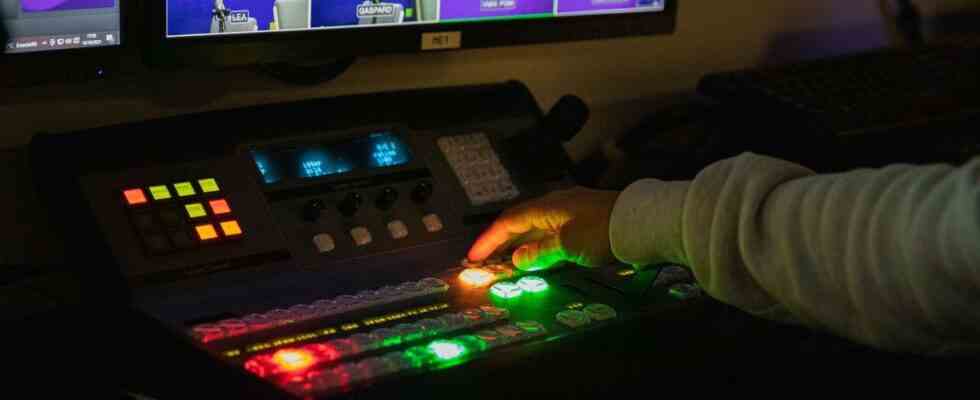Did Squeezie really provoke Wankil Studio’s Laink and Terracid into stealing their Wednesday night slot? Welcome to the (still) small world of Twitch, its (almost) ruthless universe and its streamers in search of visibility. “Exactly like on television, it is the law of the most popular who wins, exclaims Virginia Spies, media analyst and semiologist. The access war between Hanouna and Daily, it’s the same thing: the strongest wins”. So is Twitch just the 2020s version of “Dad’s TV”? OK, those are two image media. And after ? What are their similarities? Are we going to witness the arrival of well-oiled programming on Twitch and a Télé-Loisirs platform?
But first, a little background. At the end of the summer, when well-established shows on Twitch announce their return to school, an earthquake occurs in the world of streamers and their communities: the Wednesday evening slot from 8 p.m. is suddenly squatted simultaneously by two platform heavyweights Wankil Studio and Squeezie. The latter, YouTube star, was not unanimous in switching from Thursday to Wednesday for his stream. It even triggered an avalanche of tweets from disgruntled Internet users. Not enough to destabilize Squeezie, who did not respond to our interview request and stayed the course by imposing his stream on Wednesday evening.
The direct sacrosanct
For the content creator and his very large community, made up mainly of teenagers and young adults, the arrival on Twitch was made from the beginning of the platform, in 2017. Squeezie saw the interest of the platform in complement to YouTube, the social network that made him famous, and on which he has more than 17 million subscribers. Not surprising for Virginie Spies, who notes the complementarity of the two: “YouTube and Twitch are both audiovisual media, but the essential difference is the DNA of Twitch, which is the same as that of television, namely the live”.
Because during a stream, it is indeed live that the creator exchanges with his community. “When television arrived during the Second World War, but especially after the war, its main difference with the cinema, which had already existed for fifty years, was live,” recalls the researcher.
And this live “carries several concepts: anything can happen, there can be no cut or assembly. It’s about living together, living it at the same time as the broadcaster, but also as the other spectators. So it’s sharing with a community. », Analyzes Virginie Spies, who made an episode of it on her YouTube channel Almost perfect media, in a 2017 episode titled The powers of live.
To share and experience the power of live, the streamer needs, like the TV broadcaster, to impose a schedule of date. “Yes, it’s true, Twitch gives the impression of reinventing date television,” enthuses the semiologist, who points out that from a medium for gamers, “Twitch is gaining ground by becoming a platform for entertainment “. Like television, then.
Samuel Etienne, journalist for France Télévisions and now heavyweight on Twitch – notably with his daily press review -, shares the vision of a common essence between the streaming platform and TV. “What’s hot on Twitch in the talkingit looks more and more like TV, he said in the Friday show The Hebdo is yours September 9. When we take the flagship show Pop corn, it’s a set, people in the studio, columnists, a management”. “It’s television and it’s not a dirty word, abounded in the stream Thierry Moreau, journalist and streamer. Young people watch less television but they watch audiovisual content. It is only in another form in its temporality, its duration, its creativity, its interactions”.
Borrow the codes by adapting them
Virginie Spies speaks of “a shift in platform and generation. We often see parents who have fears about Twitch and their offspring. But it is only a platform adapted to this new generation. Where parents watched Dechavanne at 7 p.m., younger ones tune into Twitch to follow the hottest streamers.” For Samuel Etienne, the time has come for the “hybrid concept. All the inventions on the new screens, the experiments carried out on the new platforms, like Twitch, are the future”.
If using TV codes for streamers, or even taking over programs and adapting them to the platform is a priori commonplace, the opposite is not true: TV is really struggling to adapt to Twitch. “A channel like TF1 cannot do TF1 on Twitch or TikTok, explains Virginie Spies. It must adapt its content, or even create a specific one”. History to avoid the resounding failure of the interview of Gabriel Attal by EnjoyPhenix in the show #SansFiltre, on the channel of the Minister of Public Accounts in 2021? “A transfer to Twitch of “Dad’s TV”, a show on set where politicians are questioned by influencers, does not work”, assures the media analyst. Borrowing TV codes, or even drawing from existing TV games, is a big yes, but the key word is adaptation.
The economic model, the sinews of war
As for Youtube fifteen years ago, Twitch is a network that brings together the youngest, favorite target of advertisers, yet very difficult to capture. “Today, some Youtubers are 40 or 50 years old, but they are where the debates and the issues take place, that is to say on Twitch”, recalls Virginie Spies. However, these young audiences consume platforms where the reign of advertising and subsidies has been abolished. “On Twitch as on other platforms, business models are very fluid. As on Youtube, it is plural: there are subscribers, advertising, crowdfunding, partnerships, sponsorship, book writing, film production, etc. “, she explains again.
If the Twitch’s latest announcement on how it will change the remuneration of content creators is not to everyone’s taste, it still allows small channels to offer new content. “This wind of freedom is really a strength of Twitch, it makes you think of the beginning of free radio stations”, compares the researcher. So radio or TV, finally, Twitch?

